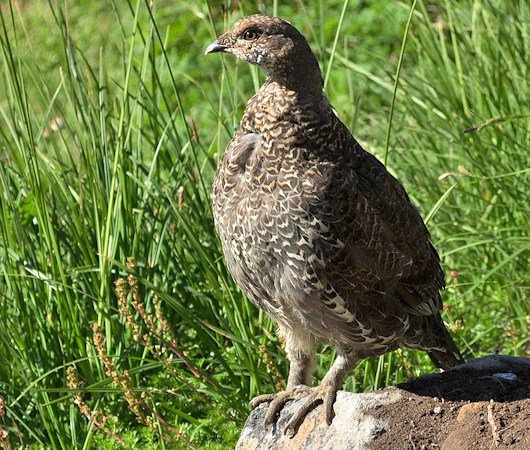Climate change threat: Mount Rainier white-tailed ptarmigan

MOUNT VERNON, Wash. (AP) — The U.S. Fish and Wildlife Service proposes listing a bird found in the North Cascades as threatened under the Endangered Species Act. That's due to the likelihood that climate change will shrink its high-elevation habitat throughout the state.
The Mount Rainier white-tailed ptarmigan is found in the Cascade Mountains, from southern British Columbia to southern Washington.
They are one of few animals that spend their entire lives on mountaintops. They move seasonally between snow-covered habitat and summer alpine meadows.
As temperatures continue to warm, the region’s snowpack will decline. Alpine meadows may also be at risk as conditions move tree lines to higher elevations.
News release from the Center for Biological Diversity:
Threatened by Climate Change, Mt. Rainier Ptarmigan Proposed for Endangered Species Act Protections
Winter-Adapted Grouse Threatened by Warming Temperatures, Receding Glaciers, Wet Snow Across Washington Cascades
SEATTLE— In response to a petition and litigation by the Center for Biological Diversity, the U.S. Fish and Wildlife Service proposed today to protect the Mt. Rainier white-tailed ptarmigan as a threatened species under the Endangered Species Act. Following a Trump administration regulation, the Service declined to identify and protect critical habitat for the ptarmigan.
“These beautiful winter birds are immediately threatened by our warming world, so even these limited protections are helpful,” said Noah Greenwald, endangered species director at the Center and author of the petition to protect the ptarmigan. “Like a canary in a coal mine, the ptarmigan is telling us that we’re losing the snowpack that keeps Washington’s streams cool and flowing throughout the summer. It’s very alarming.”
The ptarmigan lives year-round above the tree line in the Cascades from southern British Columbia to Mt. Adams. In winter, it relies on dry, fluffy snow to bury itself and stay warm, but climate change is resulting in more rain on snow events, creating hard crusts unsuitable for the bird.
In summer, the ptarmigan prefers wet areas created by melting snowfields and glaciers that are rapidly disappearing. It is poorly adapted to warm temperatures, showing stress above just 70 degrees Fahrenheit.
The Cascade alpine meadows used by breeding ptarmigans are expected to decline by 95% in the next 50 years under current climate change projections.
“Our world is changing and changing fast,” said Greenwald. “If we don’t move quickly to drastically reduce fossil-fuel usage and protect more of the natural world, the ptarmigan will be one of many special things we’ll lose in the Pacific Northwest.”
The smallest bird in the grouse family, white-tailed ptarmigans are one of the few animals that live on alpine mountaintops throughout their entire life. They’re adapted from head to toe to thrive in a frigid climate, with feathered, snowshoe-like talons, seasonally changing plumage and a remarkable ability to gain body mass throughout harsh winters.
But as hotter temperatures sneak up the mountainsides, pushing tree lines — and the ptarmigan — to ever-higher elevations, there may be no more room to rise in the near future.
In addition to climate change, the ptarmigan is threatened by recreation in both winter and summer, which can disturb birds.
“It’s disappointing to see the Service following Trump administration rules and denying the ptarmigan critical habitat,” said Greenwald. “Protection of critical habitat could have helped identify the most important places for the bird and ensure these areas aren’t unduly disturbed.”